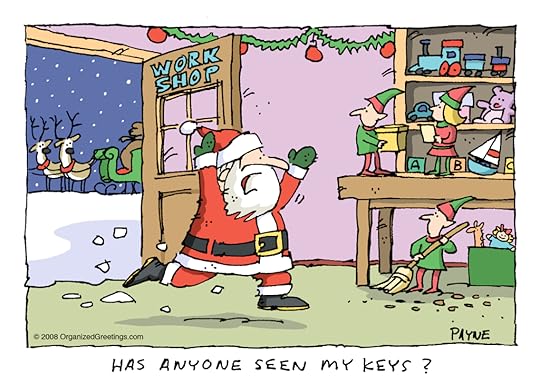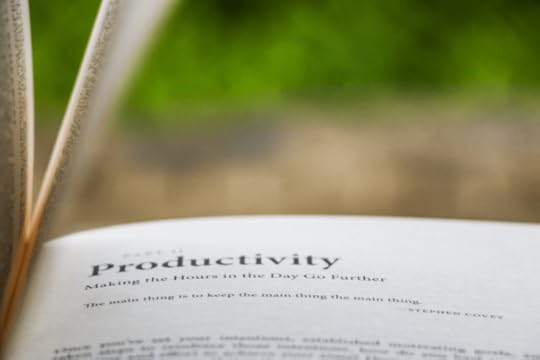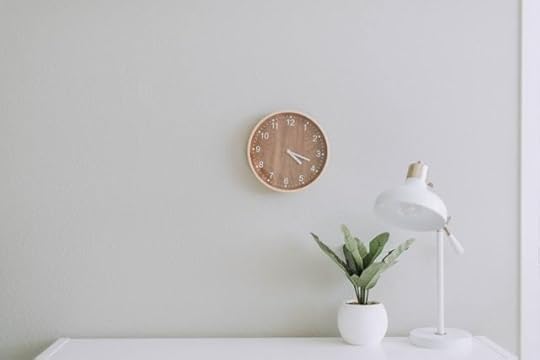Donna Smallin Kuper's Blog: The One-Minute Organizer Blog
November 30, 2021
Hello world!
Welcome to WordPress. This is your first post. Edit or delete it, then start writing!
January 15, 2021
Farewell Giveaway

As you know, my husband and I have been full-time travelers ever since he retired in July 2013. We love the RV lifestyle and plan to continue traveling.
What you didn’t know (because I never told you) is that I’ve been semi-retired for a few years now. I’ve continued to blog and send my quarterly organizing tips newsletter and other emails to my subscribers. And I’ve written some articles like this one about RV Space Hogs.
But the time has come to say goodbye. I’ve decided to retire, effective immediately. So this will be my last blog post.
Click Here to Enter My Farewell Giveaway!I want to thank you for your support over the years with a farewell giveaway. I’ve got some great prizes for you, including…
Enter to win the newly published paperback book entitled Filled Up and Overflowing: What to Do When Life Events, Chronic Disorganization, and Hoarding Go Overboard , co-authored by my colleagues Diane Quintana and Jonda Beattie (Value $19). In addition to entering to win this book, you are invited to register for their virtual book launch party on January 20th at 7pm EST. The online event is free, but registration is required to attend. It’s a great way to meet the authors and get some good tips!2. Enter to win a 6-month subscription to My Basic Home (Value $54) from professional organizer Janet Schiesl, owner of Basic Home Organization. The subscription includes daily texts or emails each weekday. There is a theme each week. Each organizing exercise should take about 15 minutes. Cost is 9.99 for a monthly subscription, 8.99 per month if you sign up for 6 months, and 7.99 per month for a one-year subscription. The subscription also includes access to a private Facebook group where members can support each other. A lot of the exercises also include links to blog posts, videos or products to support the daily exercise. Your start date is whenever you sign up – or whenever you win!
3. Enter to win a series of ebooks published by Smead that include tips from professional organizers (including yours truly) – Room by Room Organizing, Office Organizing, and 100 Organizing Ideas. I’m going to draw 20 winners for this prize. If you win, I’ll be in touch so I can email your ebooks.
Other Things You Should Know Before I GoI plan to sell Unclutter.com. Until the domain is sold, you’ll continue to have full access to all the content on my site. Remember that you can use the search feature to find blog posts on specific topics.
If you are on my email list, rest assured that I will NOT sell your email your address. That’s a promise I made to you when you signed up and I will keep that promise.
You’re welcome to join my free organizing support group on Facebook. It’s a great group for getting and giving decluttering ideas. I love how our members support and encourage each other on their journey to a more organized life. I’ll pop on from time to time.
If you have an interest in minimalism, a colleague is launching a Simple Reading newsletter with historical writings on simple living and minimalism. Whether you’re someone who is looking for more simplicity in your life or are merely curious about minimalism from an academic perspective, the Simple Reading newsletter will have something for you. The first email is January 21 and will be sent every two weeks after that. In a year, just by reading emails, you’ll be exposed to hundreds of years of literature. You’ll be introduced to the words of Lao Tze, Gautama Buddha, Marcus Aurelius, Anna White, and so many more. The subscription is free and is produced by author Erin Rooney Doland. I thought it sounded very interesting, so I signed up.
Lastly, don’t forget… registration for Joshua Becker’s Uncluttered course closes Sunday, January 17. This is a 12-week online course designed to help you own less, live more, and discover the life you’ve always wanted. The New Year’s Edition of the Uncluttered course will start Tuesday, January 19. The cost is $89 for the general public. But Joshua gave me a Friends & Family discount code to share with you – enter FF25 at checkout to save 25% off this course. Click here for a full description of the course and what you can expect. But don’t wait too long because registration closes on Sunday, January 17, 2021 and I wouldn’t want you to miss out.
Goodbye Friends!Well. I guess that’s it. It’s been an honor to share my expertise with you via this blog and my books. I’ll miss our interaction, but I’m excited to embark on this next chapter of my life.
“Please watch out for each other and love and forgive everybody. It’s a good life, enjoy it.”
Jim Henson, creator of The Muppets
The post Farewell Giveaway appeared first on Declutter Your Life with Donna Smallin Kuper.
December 18, 2020
How to Maintain an Organized Home Throughout the Holidays
With December in full swing, you may feel like your home is getting out of control. Preparing for Christmas and New Year festivities on the tail of Thanksgiving can make your head spin. Just trying to keep up with the tree needles shedding can be stressful! And with so much on our minds, it’s easy to misplace things.

We experience this every year, yet we still find ourselves losing control of our living space and are left with a cluttered mess to work through by the time January rolls around. However, this can be the year to put an end to the chaos so we can relax and enjoy a clean home. Think of it as starting your New Year’s resolutions a little early. Become the “better you” now by implementing these tips to maintain an organized home throughout the holidays.
Have cleaning tools on hand
Cleaning is one of those things we tend to dread, but in reality, doesn’t take much time. The thought of the chore is ultimately worse than the chore itself. Sometimes, half the battle is just having the right supplies on hand! Being prepared with the right tools can save you when faced with the inevitable messes that come hand in hand with the holidays. When you’re out doing your last-minute grocery shopping, be sure to swing by the cleaning aisle to stock up on extra essentials like dish detergent, carpet cleaning solutions, and paper towels.
If you find yourself without something you need, you can order online and have it delivered. This household essentials delivery service, for example, can deliver cleaning products right to your home in as little as 30 minutes, so you can stay put and focus on your holiday preparations. Home delivery saves time and with Christmas just a week away, time is of the essence!
Simplify your decorations
Some of you might find this tip a bit tough to follow, but stay with me. Christmas decorating is an integral part of the season; however, as with many things, less is more. Think like a museum curator when decorating and choose the decorations that make your home festive without making it look cluttered.
If you’re still setting up your holiday decorations, make a decision to donate decorations you haven’t used in years. Not only will this minimize clutter, it will also make the clean-up after the holidays so much easier. If you’ve already decorated, take a walk through your home. Does it still feel comfortable? Or does it look cluttered? Remember that clutter directly impacts your well-being. Find what makes you feel content and leave it at that.
Clean as you cook
As we all know, cooking can get very messy, very quickly. Cleaning as you go is the way to stay on top of it. Also, counter space is critical, so really look at what’s taking up that important real estate. My mantra is this: If you use it every day, it gets to stay; otherwise, put it away.
It is also very important to not refuse help. Assign cleaning tasks to family members and visitors. Make lists of what needs doing so you don’t have to keep it all in your head. You’ll be less likely to forget something important that way. It will also allow a smoother transitions from preparation to enjoying the fruits of your labor to cleaning up.
Make a list and check it twice
Take Santa as your mentor here. Lists can help immensely when you’re trying to organize your thoughts. Keep a notebook handy or use a notes app on your phone. Once your brain is organized, the rest will follow. It can be all too easy to become overwhelmed when there are a million tasks to get done. From shopping for presents to baking a fresh apple pie, lists will make these holiday activities pass by with ease.
Efficiency is key for staying organized throughout the holidays. With a phone application, for example, you can sync tasks with your digital calendar and set reminders for yourself. Check out of some of the best to do list apps to help achieve your organization goals now and into the new year and beyond.
What are your best tips for how to maintain an organized home throughout the holidays? We want to hear from you, so please take a moment to share in the comments below!
The post How to Maintain an Organized Home Throughout the Holidays appeared first on Declutter Your Life with Donna Smallin Kuper.
November 12, 2020
Repurpose & Reuse: 6 Home Quarantine Projects

We’ve all been spending more time at home than usual, so it’s no surprise that home projects have flourished. You’ve likely been busy with home quarantine projects such as cleaning out closets, and generally decluttering and re-organizing your home.
As you go through your home, exploring boxes of whatnots, you’ll find plenty of things to throw away, for sure. But you may find items that you can repurpose and reuse. Here are a few home quarantine projects that can keep you engaged, entertained, and even organized during your time at home.
1. Remake an Old Rug
In addition to providing a bit of softness and breaking up floor space, rugs can create cohesion in a room. Beautiful rugs can be expensive. But you can make an old rug look like new with a simple—and inexpensive—box of dye.
Clean the rug first, then follow the directions on the box. Just be sure that you pick out the appropriate dye. You won’t want to buy a synthetic dye for a rug with natural fabric or vice-versa. Pour the dye into a spray bottle. You only need to spritz the rug, although you may have to go over it more than once.
2. Transform a Light Fixture
If you have some silk flowers, there’s more you can do with them than just put them into a vase. Turn them into something new and magical simply by twining them around a lighting fixture to create a fabulous floral chandelier. This repurposing trick works best with hanging fixtures, but you can also transform other types as well.
3. Refresh Your Entryway with a Window
Old windows are a recent mainstay in the world of decor. People snatch them up from antique shops and curbsides. If you’re lucky enough to have one (or find one on the cheap), you can turn it into a entryway organizer.
Paint one (or two) panes with chalk paint to create a blackboard surface. Paint another white or attach a fitted sheet of cork to form a corkboard. In the other frames, you can affix family photos or other images. Glue, nail or screw a small piece of wood to the bottom of the frame to create a shelf. Attach hooks to the bottom of the shelf and you have a spot to hang your keys.
4. Get Creative with Wine Corks
DIY cork crafts were all the rage just a few years ago. They were popular as wedding decor and shabby-chic home decor. If you have a collection, then you can repurpose them into something practical rather than counting them as clutter and tossing them in the trash.
Cork makes the perfect bottle stopper. You simply need a topper, such as rock crystals, gemstones, or small animal figurines, which you can paint a different color. Using hot glue, affix them to the tops of the corks, and voila. They make excellent gifts, but save a few for your home bar, too.
5. Make a Mirror into a Tea Tray
You can never have too many mirrors, but mirrors that hang on the wall do take up more than their fair share of real estate. The good news is that mirrors are easy to transform. Framed mirrors are particularly fun to repurpose. If you like, you can paint the frame itself. You can paint the mirror as well.
Chalkboard paint will turn the mirror into a reminder board. Or you can leave it be to make a tea tray or a tray for a candle display. It’s also possible to cover the mirror with a resin composite, complete with any colors or details you choose, and use it as a cheeseboard or tray to contain miscellaneous items, so your counter or coffee table doesn’t get cluttered.
6. Turn Jars into Organizers
Got a cabinet full of mason jars? To repurpose mason jars, you simply need to think outside the box—or the jar, as it were. Jars make handy organizers. With a simple paint job, you can turn yours into charming, vintage-inspired apothecary jars.
Use them to declutter your hobby room or keep them in the bathroom, with or without their lids, to hold everything from cotton swabs to toothbrushes or a place to store makeup brushes. Larger jars will be at home in the kitchen, where they can hold utensils. Or screw a row of lids under your cabinets, fill the jars with dry goods such as popcorn, beans or grains, and reattach the jars to the lids.
You make be stuck spending time at home while we’re waiting for the coronavirus vaccine, but that time doesn’t have to be boring. Have you done any fun home quarantine projects during the pandemic? Please share!
###
Katie Tejada is a writer, editor, and former HR professional. She enjoys writing about decorating trends and innovations for the home, but also covers developments in HR, business communication, recruiting, real estate, finance, law, and investing. If you like this article, you might want to read Katie’s previous guest blog post about How to Organize Your Kitchen.
Photo by Carolyn V on Unsplash
The post Repurpose & Reuse: 6 Home Quarantine Projects appeared first on Declutter Your Life with Donna Smallin Kuper.
October 21, 2020
7 Fall Weekend Decluttering Projects

Fall is the perfect time to declutter your home and make your living space more comfortable and functional. Here are seven fall weekend decluttering projects that will help to simplify your life over the next few months and beyond.
1. Examine Your Wardrobe
Now that the weather is getting cooler, it’s time to switch out summer clothing for fall and winter clothing. As you remove warm weather clothing from your closet and drawers, take note of the things you never wore over the past season. Maybe there’s a bathing suit that no longer fits or a pair of sandals that hurt your feet. There’s no point putting them away – toss them into a donation bag instead.
Then, do the same with your fall and winter clothing. Before putting it away, have a close look at all those sweaters and pants that spent the entire season doing nothing but taking up valuable space. If you didn’t wear them last year, you’re not likely to wear them this year. You know what to do – toss them in your donation bag. Or, if they’re in good shape and still in style, take them to your local consignment shop or try selling them online.
2. Clean and Store Summer Linens
Bedding should be cleaned and changed out with the seasons. That pretty summer coverlet looks nice, but it won’t keep you warm on cold winter nights. It’s time to put it away.
Before putting away your summer linens, look at them with a critical eye. You might have sheets that have holes, pillowcases with frayed ends or comforters with permanent stains. Fall items you’re bringing out should also be looked at. Maybe it’s time to replace that lumpy quilt or worn flannel sheets. Bag them up and donate to your local animal shelter for use as animal bedding.
3. Declutter Your Attic (and/or Basement)
If you have an attic, chances are you didn’t spend a lot of time up there during the summer months. Head upstairs and have a look at it now. What’s up there – and why?
If you’re storing things for a specific need in the future, great. But if the only reason they’re up there is because you didn’t know what else to do with them, maybe it’s time to move them out of your home. The same goes for things in your basement.
4. Get After Your Garage
Over the summer, you’ve probably put lots of things in the garage. This is a good opportunity to think about what you really need and what you don’t, especially if there’s no room for your car! Start by removing all of those outdoor items that are broken or you no longer have use for. Here’s a step-by-step plan for cleaning out your garage in a weekend.
5. Hold a Yard Sale
A yard sale is a good way to get rid of things that are still in good condition, but you don’t use anymore. Pick a nice weekend day with a good weather forecast. List your sale on Craigslist and also GarageSalesTracker. Put up lots of signs in advance leading from the nearest main road. Make sure you have lots of petty cash so you can make change when you’re selling.
6. Donate Things to Charity
A charitable donation benefits you and others at the same time. Look through your things. Many of the items you have in your home that you don’t want are likely still in good condition. For example, if you have small children, they’ve probably outgrown their baby clothing while it was still in good condition. Others can make use of these items. Donate them to a good charity. Many charitable organizations, such as the Vietnam Veterans of America, will even come and pick up your donations for free.
7. Don’t Forget to Clean Your Fridge
Over time, the fridge can get just as cluttered as the rest of your home. A cluttered fridge can make it hard to prepare meals and find room to store food. With the holidays coming, now’s a good time to clean out your refrigerator and freezer.
Things that have been in there for weeks, months, or even years aren’t likely to wind up on your dinner plate any time soon. They’re just taking up space you need. Get rid of them and then give your refrigerator and freezer a good cleaning.
Decluttering your home now can make a huge difference in how you feel every time you walk in the door over the long winter months. Plus, you never know what the future is holding in store for you. Maybe you’ll get a new job opportunity or decide to downsize in the spring. Paring down your belongings now will make a lot easier to make your next move, whenever that may be.
###
Mikayla St. Clair is a Public Relations Specialist for Allied Van Lines. She loves to write informative
articles and share her knowledge with readers.
Photo by Jakob Owens on Unsplash
The post 7 Fall Weekend Decluttering Projects appeared first on Declutter Your Life with Donna Smallin Kuper.
October 13, 2020
4 Tips to Help You Accomplish Your Goals

It takes work to accomplish your goals. Whether they’re large or small, perseverance is key to achieving them.
It can be easy to feel overwhelmed when you’re not sure where to begin. A perfect place to start is to focusing on your natural habits. What tasks do you naturally gravitate towards? What is the most productive part of your day? Beginning here and understanding your natural rhythms can make a huge difference.
There is, however, a way to get a headstart just by optimizing your daily schedules and to-do lists. Once you have a system in place that works for you, it’s only a matter of time before you start to become more productive. Keep reading for small ways to improve your productivity and accomplish more each day.
Plan your day the night before
The simple act of planning ahead can get tomorrow and every day off to a good start and help you accomplish your goals. After dinner or before you go to bed, take a few minutes to plan your next day.
Your list can be a brain dump, but it’s important to identify the three main things you want to accomplish the following day. (I mark these with a star or you can number them 1-2-3.) Your list can deal with work things, home and family, or a specific project like cleaning out your closet.
Next, group like items such as phone calls to make or errands to run. Then block out time on your calendar for getting those tasks done. Productivity expert, Michael Hyatt, says: What gets scheduled gets done. Truth!
In addition to blocking out time for projects like writing this blog, I use my Google calendar to block out time for personal activities that are important to me such as daily exercise and clarinet practice. (I actually schedule these as recurring events.) And because I’m such an organization geek, I even color code activities.
Word of caution: Don’t schedule in every minute of your day with back-to-back activities. Inevitably, something will take longer than you anticipated or you just need a break to stretch or do nothing. Yes, doing nothing can help you accomplish your goals too!
Start with your toughest task
Is your to-do list riddled with minor tasks and then a few major ones sprinkled in? While it’s easy to gravitate towards the quick and easy tasks, you’re actually giving yourself a false sense of progress. And you’re wasting energy focusing on tasks that aren’t as critical as others.
When prioritizing your day the night before, identify the hardest task that needs doing. When you procrastinate getting the larger item done, it looms over your head for the rest of the day. This will ultimately affect your productivity with other tasks. But when you get in the habit of completing the hardest task on your list first, the rest of your day feels like a piece of cake.
Complete projects in stages
While it’s always satisfying to complete a project, sometimes it’s more productive in the long run to split large projects into mini-projects. Whether it’s an ongoing work project or your Saturday chores, you may find yourself accomplishing more when you complete it in stages.
Let’s take a deep cleaning day, for example. As we are quickly approaching the holiday season, you may already be thinking about deep cleaning your kitchen. Purchasing all of the supplies needed, on top of decluttering and then actually deep cleaning, can feel like a lot of steps. And all these steps in a row can be daunting – and may even deter you from even starting.
So take it one step at a time. Make a list of what needs to be done. Maybe start by ordering your cleaning supplies online. When waiting for them to arrive, you’ll have time to start another project on your list like decluttering your pantry. So you’re simultaneously getting two to-do’s checked off. Once you receive the essentials, you can pop right back into the next task on your “clean the kitchen” list.
Get a good night’s sleep
Sleep is directly correlated to our performance. While we all know this is true, it’s easy to sacrifice our sleep in order to finish a project. While it may feel like you’re being more productive by working late into the night, this is not always the case. When you’re exhausted, you may end up redoing tasks.
It’s important to get an optimal amount of sleep. The recommended seven to eight hours of sleep truly supports your output of work and even the quality of your work. And it’s not just quantity of sleep that matters, it’s also the quality of your sleep. If you’re tossing and turning throughout the night, you aren’t getting the restful night’s sleep you need to help you accomplish your goals.
Try tracking your sleeping habits throughout the night and pinpointing where the issue is. Maybe there’s too much light coming in through your windows – easily solved with blackout curtains. Or maybe you’re in the habit of scrolling through social media posts on your phone or laptop and the blue light is interfering with your ability to fall asleep. If so, you might find that donning blue light blocking glasses makes a difference.
Everyone is different. What’s important is to have faith in your ability to find what works for you. Ensure your environment supports your personal needs and you’ll wake up ready to tackle the day.
###
FULL DISCLOSURE: This post contains Amazon affiliate links that may result in a referral commission to me at no additional cost to you. Thanks for supporting my work by shopping via my links.
The post 4 Tips to Help You Accomplish Your Goals appeared first on Declutter Your Life with Donna Smallin Kuper.
October 1, 2020
Expert Tips for Organizing Your Home Office

If you’re working from home, you need a comfortable, efficient, and overall enjoyable space to work in. You’d be surprised at what a difference a well-designed office space can make in your productivity and attitude. Here are some expert tips for organizing your home office, whether you’re upgrading your current office or converting a spare room into your office space.
Choose the Right Furniture
When it comes to furniture, you don’t necessarily need to have all the pieces that make up a corporate office. The beauty of setting up your home office is that you get to choose the right furniture for you.
The majority of your work will be conducted at your desk, so find one that suits your needs and your style. Perhaps you want a Scandinavian-style desk to keep your space airy and light. Or maybe you prefer a heavier, darker desk with lots of desk drawer space. Either way, be sure that your desktop is big enough.
Arrange furniture so that you can get up and comfortably walk around your home office without bumping into furniture. Most people prefer their chair and desk face the door, but whatever configuration works best for you and your space is up to you. Experiment to find the best set-up.
Decorate Your Office
You don’t have to spend a fortune on office decoration. Work with what you have. You can decorate with photos, artwork, framed posters or certificates.
Having a plant or a two in your home office may also be beneficial, especially if you add in plants that are known to improve the air quality such as spider plants. Also, did you know that green plants can help you better focus on the tasks at hand? A research study conducted at Exeter University in the U.K. found that indoor plants can improve productivity by as much as 15%.
Taking advantage of vertical space can expand your working space, especially in a small office. For example, hanging a narrow shelf on the wall directly over or behind your desk expands your worktop and gives you a place to set small items such as a stapler and container for pens and pencils.
Or maybe you’d prefer to hang a large reusable calendar with dry-erase markers for keeping track of projects – or a corkboard for pinning design ideas and important notes.
Stay Neat and Organized
Keeping your workplace tidy is very important. You want to have the things you use most often most easily accessible. Designate a place for everything. All your equipment, tools, and paper should be placed in the proper areas and always put back in their places at the end of the day.
Organizing your desktop really comes down to personal style. Some people prefer to have everything out and in tidy containers. Others prefer a spotless desktop and would rather have everything organized neatly in drawers. There’s no one right way to organize your home office – only what’s right for you.
Consider Proper Lighting and Temperature
Not only can lighting affect your mood, but it can change how your phone and computer screens light up. Ensure that the lighting you install isn’t too bright or too dim and that it illuminates you well if you need to make a Zoom call. There is nothing worse than having a professional meeting online where you can’t see the participant because the backlighting is so strong. Keep in mind that natural lighting is also important, as it will affect your mood and can help you conserve electricity.
Is the temperature of your home office comfortable? Be sure your chair isn’t directly under a heating/air conditioning vent. You may prefer to keep your office on the cooler side. If that’s the case, is your home air conditioning able to tolerate keeping a consistent temperature from morning to night? Checking in with an expert in air conditioning may ensure that your office and your home is the perfect temperature all year round.
So much of setting up a home office is really personal, from your chair to the decor. You want this space to work for you. Just remember, the more comfortable and organized your home office is, the more efficiently you will be able to work.
###
Allie Shivers enjoys reading, quilting, and researching how to move abroad with her bull terrier, Fritz. As a freelancer, her niche is writing about interior decor and business automation.
Photo by Samantha Gades on Unsplash
The post Expert Tips for Organizing Your Home Office appeared first on Declutter Your Life with Donna Smallin Kuper.
September 23, 2020
Managing Clutter and Depression

If you live in a home that is cluttered, you may be struggling with depression. That can make it difficult to keep up with housework and stay organized. Taking action to declutter your home may help you fight off some of the symptoms of depression and improve your daily outlook. Here’s how clutter and depression are related.
Clutter Causes Lower Self-Esteem
Living in a constant state of disorganization can be difficult and stressful. When you can’t find your keys, miss deadlines, or misplace important papers time and again, it’s easy to feel overwhelmed and sad.
Living with clutter may also affect your self-esteem. Unfinished to-do lists and piles of stuff that need to be put away all have a negative effect on your self-esteem which can drag you down into depression.
It’s not easy to accomplish things when you’re struggling just to stay afloat day after day. Sometimes, just clearing out a bit of clutter or making a list of things to do can begin to improve your mood, making it feel like things are a little more manageable.
Start Small
When you decide to begin the decluttering process, it’s important to start small so that you don’t get overwhelmed. Set small goals.
Start by clearing out clutter for a certain amount of time each day. Alternatively, get rid of a specific number of items each day, or sort through a single room.
Keeping a task to a manageable size allows you to see progress slowly. The state of your home will gradually improve without you burning out from doing too much at one time.
Build Routines
Begin to fight through your depression by slowly building routines that will improve your environment. Making your bed every morning is one routine that many people find helpful. You might also schedule a certain time every day to work on clearing clutter. Choose a time when you typically have the most energy.
Sticking to a schedule and making gradual progress is more important than how much you remove per day or how much visible cleaning you get done. These positive routines will slowly become second nature and getting things done will provide positive reinforcement.
Your self-esteem will build as you prove you can do it. As you see small areas of your home begin to look nicer than they did, you may feel your depression lift.
Create Welcoming Spaces
Your home should be a space that you can relax in and feel as comfortable as possible. So as you declutter, think about what makes you feel cozy, and comfortable. In your bedroom, for example, do you prefer more or less light in the room? Are you happy with the color of the walls?
Sometimes making just one or two small adjustments after getting rid of clutter on surfaces can help make a room feel more welcoming. Do what it takes to feel more at home in your own space.
Be Honest with Yourself
When you frequently can’t find things, it’s easy to feel as if you aren’t functioning very well, and this feedback loop can worsen your depression.
But don’t be fooled that the clutter in your environment is the sole reason that you experience depression and anxiety symptoms. While a cluttered environment can cause stress and increase your cortisol levels, making you feel on edge constantly, there may be more serious mental or physical problems at play.
If you can’t declutter or keep up with basic household tasks due to the severity of your depression symptoms, it may be wise to speak to a mental health professional for assistance.
Clutter and Depression AND Addiction
If you use substances to cope with your stress or depression, you may have a substance use disorder, more commonly known as addiction or dependence. If you only started to feel depressed or anxious after you began using substances—alcohol, stimulants, opioids, benzodiazepines—then these substances might be causing them.
When you have substance abuse and a mental issue such as depression, it is known as dual diagnosis or co-occurring disorders. Regardless of which came first, both now need to be treated. A drug rehab facility near you may be able to help you handle both the depression and the addiction so that you can begin to live the clean, organized, drug-free life you’ve always wanted.
###
Patrick Bailey is a professional writer mainly in the fields of mental health, addiction, and living in recovery. He attempts to stay on top of the latest news in the addiction and the mental health world and enjoy writing about these topics to break the stigma associated with them.
Sources:
additudemag.com – The FlyLady Has the Cure for Your Messy House Syndrome
miadanielle.com– Massive Psychological Effects of Clutter, According To Science
nourishingminimalism.com – Combat Depression with Decluttering
blurtitout.org – Decluttering: How It Boosts Mental Health
Photo by Joshua Rawson-Harris on Unsplash
The post Managing Clutter and Depression appeared first on Declutter Your Life with Donna Smallin Kuper.
September 18, 2020
Simple Tips to Keep your Home Safe

Just as regular cleaning and decluttering helps to keep your home safe, there are some simple things that you, as a responsible homeowner, should tackle to ensure the safety of all who enter your home. Right now, at the start of the fall season, is a good time to take care of these important home maintenance tasks.
Change Batteries in Smoke Detectors
Start by changing all the batteries in your smoke detectors. This is easy with the help of a ladder and someone holding that ladder while you remove the cover of the smoke detector, then remove the current batteries and replace them with fresh batteries.
Most smoke detectors will allow you to test the sound the smoke detector will emit in case of a fire. Be sure to test each smoke detector.
Change Air Filters
Air conditioning/heating filters need to be changed periodically – and they are so simple to change. Simply pick up the size of your current filter from your local hardware store, then out with the old and in with the new.
New filters will ensure that the air in your home is good and that your heating and air conditioning units are working effectively. Clogged and dirty filters will affect your heating and air conditioning units and could create a potential risk for your family.
Clean Dryer Vent
A simple task that needs to be completed annually is making sure your dryer vent is free and clear of lint. Dryer lint buildup is the leading cause of home fires. It’s not enough to just clean the lint filter after every use. Be sure to clean the dryer exhaust vent, hose and lint filter trap, especially if your dryer has been running hot or taking longer than usual to dry clothes.
You’ll want to clean it at least once a year. You can clean this yourself with a special dryer vent cleaning kit or hire a professional. While you’re at it, vacuum any lint that has accumulated on your walls.
Scrub the Ventilation Hood
Like the dryer vent, your stove’s ventilation hood can be a fire hazard. Ventilation hoods accumulate grease which is highly flammable. Removing the filters and soaking them in soap and water, then giving them a scrub will eliminate the grease.
Remember to clean the ventilation hood along with the filters to remove any dirt and grease. Cleaning your ventilation hood will also help remove any odors or bacteria that may have accumulated from cooking.
Check Pool Safety
If you have a pool, check areas around the pool. Reviewing your pool fence area to make sure the fence does not have damage or open areas which could allow for pets and children to enter. Drowning is common where pools are concerned and making sure the fence is secure is important.
Additionally, checking the latches or replacing them with self-closing latches will also ensure the area is safe. Be sure to always secure basket filter covers to minimize any potential risk to visitors to your home.
Schedule Maintenance Tasks
Tracking all your home maintenance can be challenging and often times hard to remember when you last performed the task. But using your own calendaring system or a home maintenance tool that electronically sends you notifications can help you stay on top of all the tasks needed to keep your home safe.
With these simple tips you can get your home in tip-top shape while also protecting it and your family from any potential hazards. These tips will also keep your home running smoothly creating efficiencies of your equipment, which helps to keep your energy bills manageable.
###
Elizabeth Dodson is the co-founder of HomeZada, a cloud-based home improvement and organizational software tool. HomeZada strives to educate and provide resources for homeowners in all areas of home management, including home improvement projects, maintenance, inventory, property information, and property value.
FULL DISCLOSURE: This post contains affiliate links that may result in a small referral commission to me at no additional cost to you. Thanks for supporting my work by shopping via my links.
Photo by Alisa Anton on Unsplash
The post Simple Tips to Keep your Home Safe appeared first on Declutter Your Life with Donna Smallin Kuper.
September 14, 2020
How to organize your family tree at any budget

This post was originally published on June 24, 2017.
Genealogy research can be an expensive hobby if you factor in computer programs, tools, memberships, documentation fees, research trips, books, seminars, and conferences! (Hmmm, wonder how much I’ve spent over the years? Not to mention the time invested…)
But it doesn’t have to cost a penny.
I want to help everyone who’s interested in discovering, organizing, preserving, and sharing their family histories regardless of where they live, or how much money they have. But there’s only one of me, and I need to make a living too (so I can’t work for free). In this post, I’ve listed some options for researching and organizing your documents, memorabilia, and photos, in order of affordability.
Free ways to do genealogy research:
People have been using paper records, and storing their pedigree charts in binders and folders for centuries. And they still work!
Here’s a free Family Group Sheet to get you started. HINT: Start with yourself and work backwards one step at a time. Don’t skip any steps!
Interview your oldest living relatives before it’s too late! Don’t wait.
Gather together family documents, old bibles, certificates, records, and photographs and store them somewhere safe.
There are lots of free online resources. Try familysearch.org, and cyndislist.com for starters.
Check your local public library to see if they offer free access to Ancestry, and other databases, like mine does.
Visit other libraries in your area, including LDS Family History Centers, which are open to the public.
Use Evernote, or your own filing system, to organize your electronic records, digital photos, scans of paper photos and records, and the things you find online.
Check out my Genealogy Resource Roundup for more ideas.
Schedule a free 20 Minute Phone Call if you’d like my help getting started.
Inexpensive ways to do genealogy research:
Join a local genealogy society, or one in a region you are researching. The annual fee is usually nominal and some of them have free webinars (new, live, and archived) available to members.
Purchase a genealogy program for your computer, such as Family Tree Maker or Roots Magic, to help you keep track of your data and share it with others. Don’t forget to back up your computer files!
Order the Org4life Ancestry Clutter Flow Chart. It will help you distinguish the treasures from the trash you will find in some of the online public family trees.
Schedule a free 20 Minute Phone Call if you’d like to discuss coaching options. I can teach you how to do your own research! (This is an ideal virtual service.)
Worth every penny…or so my clients say…
Consider Org4life Family History Research Services (available virtually anywhere).
Order The Gift of an Organized Family Tree for yourself or for a loved one. (This is an ideal virtual service.)
Schedule a free 20 Minute Phone Call if you’d like me to do it for you, or if you’d like to buy a gift certificate for the genealogist in your family.
NOT Recommended:
Do nothing.
Continue letting valuable documents and photos languish and deteriorate in boxes in the garage.
Procrastinate asking the older generation about their lives — and who’s in all those photos? — until it’s too late.
Don’t organize your own genealogy materials…unless, of course, you want to make your research easier and more effective!
Risk leaving all your hard work to someone who won’t be able to make heads or tails of it.
Are you the family genealogist? Are you curious about your past?
What are your favorite free, and not-so-free resources?
Please share in the comments below!
###
Hazel Thornton is a virtual organizer and genealogist based in Albuquerque, New Mexico; creator of The Clutter Flow Chart Collection; and author of Go with the Flow! The Clutter-Clearing Tool Kit for an Organized Life. Visit her online at www.org4life.com.
=>>Check out a previous guest blog post from Hazel – a flow chart to help you figure out what to keep and what to toss.
The post How to organize your family tree at any budget appeared first on Declutter Your Life with Donna Smallin Kuper.
The One-Minute Organizer Blog
- Donna Smallin Kuper's profile
- 45 followers



